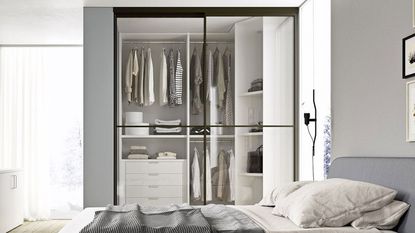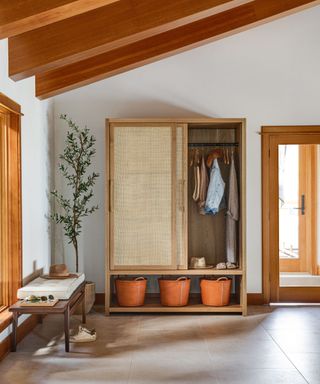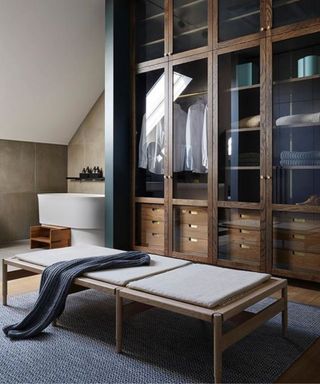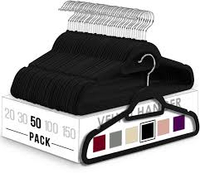How the 90/90 decluttering rule can help clear out your closet – here's how experts apply it
This quick decluttering trick takes the guesswork out of organizing clothes


It is easy to spend too much time in front of your closet wondering if you have anything to wear and what on earth you are going to put on today. If this sounds like you – it is time for a good declutter.
But, given that decluttering a closet can be incredibly overwhelming, it is easy to procrastinate until the problem gets even worse.
Luckily, the 90/90 decluttering rule can help make the decisions for you, reducing decision fatigue and making your mornings a little smoother.
The 90/90 decluttering rule
'Put simply, the 90/90 decluttering rule is an easy way to establish a solid decluttering routine to stop clothes and accessories from accumulating and becoming overwhelming,' begins Elizabeth Lulu Miranda, professional organizer and founder of Mercury Organizing.
‘This strict rule involves regularly assessing what you own without holding onto things for "someday." To declutter clothes fast, stick to the 90-day rule,’ she suggests. ‘Simply ask yourself: Do you like it? Does it fit? Will you use it in the next 90 days?’

Elizabeth Lulu Miranda is the heart of Mercury Organizing. She is an innovative and resourceful organizer who loves to help people create a better way for themselves. Elizabeth’s passion for organization and efficiency started as a child. Her mother would find her in the kitchen, rearranging the silverware and utensil drawers.
'Go through your closet, asking yourself if you still need or use each item. If not, consider donating, selling, or discarding it. You will find that you have created more space in your closet, making it easy to find what you need. Doing this every three months makes the process easier each time,’ she assures.
‘After a few rounds of decluttering with the 90-day rule, you may even be inspired to adopt a more deliberate approach to shopping. Before making a purchase, ask yourself if the item serves a purpose or if you will enjoy owning it. This mindful shopping habit can prevent impulse buys and will contribute to maintaining a clutter-free environment.’

For real efficiency and a ruthless decluttering session, Brenda Scott, professional organizer and founder of Tidy My Space recommends forcing yourself to make quick decisions and recall when you last used each item as you take it out, trying to decide whether it stays or goes within 90 seconds – like a more relaxed version of the three-second decluttering rule, perfect if you are new to decluttering.

Brenda Scott is passionate about home organizing, decluttering, and creating a safe home. At Tidy My Space, she helps people to keep their homes tidy when life gets busy. Brenda shares useful tips and gives practical help with sorting and editing her clients' spaces, leading them to feel less stressed and bringing the luxury of time to be spent with family, friends, or on themselves.
How to adjust the 90/90 rule for your closet

If you want to set yourself up for a successful decluttering session, it is important to understand the limitations of the 90/90 rule.
'When organizing a closet, for instance, you need to make some adjustments to consider your seasonal items – especially if you are organizing a closet when you don’t have seasonal storage,' reminds Amélie Saint-Jacques, professional organizer and founder of Amélie Organizes. For instance, you might have some breezy summer dresses tucked away in there that you haven't worn for six months but will wear again when the weather improves.
That being said, it can work fine for basics like bras, socks, and underwear, Amélie says. ‘But for clothing, try to work one season at a time. Now would be a good time to look at winter clothes – are you wearing the ones you own? Are there sweaters that are too itchy, fabric that is torn or pilling, turtlenecks that are too tight, and boots that are worn? Is there anything that no longer fits you?
Use the 90/90 rule to get rid of the winter items that you are no longer wearing and leave your seasonal pieces untouched for now.

Amélie Saint-Jacques is a certified KonMari Consultant and professional organizer based in San Antonio with years of experience in professional tidying.
Velvet Slimline Clothes Hangers | View at Walmart
A great trick for keeping track of what you are wearing is to turn the hooks of your coat hangers around on the rail and flip them around when you take an item out and wear it. This lets you quickly visualize which items aren't being used and can be decluttered.
FAQs
What is the 30-wear pledge?
The 30-wear pledge is a commitment you make to yourself to wear a new item of clothing at least 30 times. This forces you to reconsider hitting ‘buy now’ when shopping online or picking things up in the sale. If you cannot see yourself picking this item up regularly enough to get 30 wears out of it, it shouldn't be in your closet.
How many items of clothing is too much?
Although the idea of too much clothing is subjective, if you are struggling to navigate your closet (i.e. it is bursting at the seams), you cannot find anything to wear because of decision fatigue, or you simply feel overwhelmed at the thought of picking out an outfit, you likely have too many clothes and need to declutter.
It is not just closets that this method is useful for. ‘The 90/90 rule could also work for decluttering a kitchen, sports equipment (taking seasonality into account), or personal care products too,’ adds Brenda Scott, professional organizer. ‘The purpose is to get the person thinking about the items they've purchased. How purposeful was the purchase, or was it an impulse buy? Will you use it, or does it just take up space? Being intentional and taking the time to think about our purchases leads to a clutter-free closet and home.’
Sign up to the Homes & Gardens newsletter
Design expertise in your inbox – from inspiring decorating ideas and beautiful celebrity homes to practical gardening advice and shopping round-ups.

Chiana has been at Homes & Gardens for two years, having started her journey in interior journalism as part of the graduate program. She spends most of her time producing content for the Solved section of the website, helping readers get the most out of their homes through clever decluttering, cleaning, and tidying tips – many of which she tests and reviews herself in her home in Lancaster to ensure they will consistently deliver for her readers and dabbles in the latest design trends. She also has a first-class degree in Literature from Lancaster University.
-
 We've never seen anything like Ashlee Simpson Ross's fireplace – it makes an unrivaled statement using a classic material
We've never seen anything like Ashlee Simpson Ross's fireplace – it makes an unrivaled statement using a classic materialRoss makes a never-before-seen approach via an essential feature – its luxe, wavy appearance taps into a timeless interior trend
By Hannah Ziegler Published
-
 The brief was elegant but personal – here's how designer Nina Magon nailed this tricky balance
The brief was elegant but personal – here's how designer Nina Magon nailed this tricky balanceThis Dallas home is the epitome of luxury, but it also has charm and character. Here Nina Magon talks us through how she expertly blended perfection with personality
By Hebe Hatton Published
